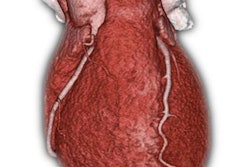Sunday, November 27 | 11:15 a.m.-11:25 a.m. | SSA04-04 | Room S504AB
Belgian radiologists tested noninvasive fractional flow reserve CT (FFR-CT) to find out if it really reduced unnecessary invasive angiographies in chest pain patients undergoing coronary CT angiography. Their answer was yes, emphatically."Before adopting the technique in our working algorithm, we wanted to be sure that FFR-CT was really working," wrote Dr. Kristof de Smet in an email to AuntMinnie.com. They needed internal validation "to convince our cardiologists to implement this new technique in the diagnostic workup of patients with stable chest pain," said de Smet, a radiologist at University Hospital Brussels.
Their study retrospectively examined 48 patients with stable chest pain, positive exercise ECG, and intermediate (50% to 70%) coronary CT angiography (CCTA) stenosis who were referred for invasive coronary angiography and conventional fractional flow reserve analysis (HeartFlow). The FFR-CT analysis was blinded.
The results showed that an FFR-CT-guided diagnostic strategy would have reduced unnecessary invasive angiography and conventional fractional flow reserve procedures by 85%, "thereby immediately reducing the inherent risk of an invasive procedure" such as coronary dissection, de Smet said. Substantial cost and radiation exposure savings will be detailed in the presentation.
These results suggest the viability of this technique as a true gatekeeper for the cath lab, and they are in line with the findings of the Prospective Longitudinal Trial of FFR-CT (PLATFORM), de Smet said.
More research is needed, "but I think it's time to stop denying the light of the sun," he said. "It's a very promising technique which cardiac radiologists and interventional cardiologists should embrace rather than deny."




















